Learn how to make a sourdough starter from scratch with einkorn! Includes quick tips for maintenance and feeding, plus recipes for using leftover discard!
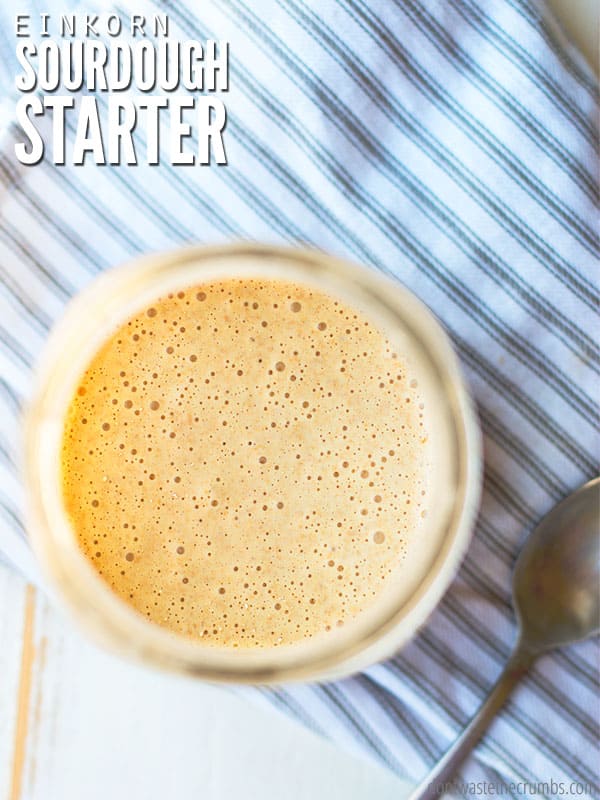
One of my goals for this year was to learn how to make einkorn sourdough.
In order to do that though, you have to first learn how to make an einkorn sourdough starter.
Considering you start with just einkorn flour and water, it can’t be too hard, right
Right! In fact, making an einkorn sourdough starter is probably one of the easiest ferments you’ll ever make.
Well, I say that about milk kefir, and I’ve said that about homemade yogurt before, too…
But this time I mean it.
It’s literally flour and water and air– and that’s IT!
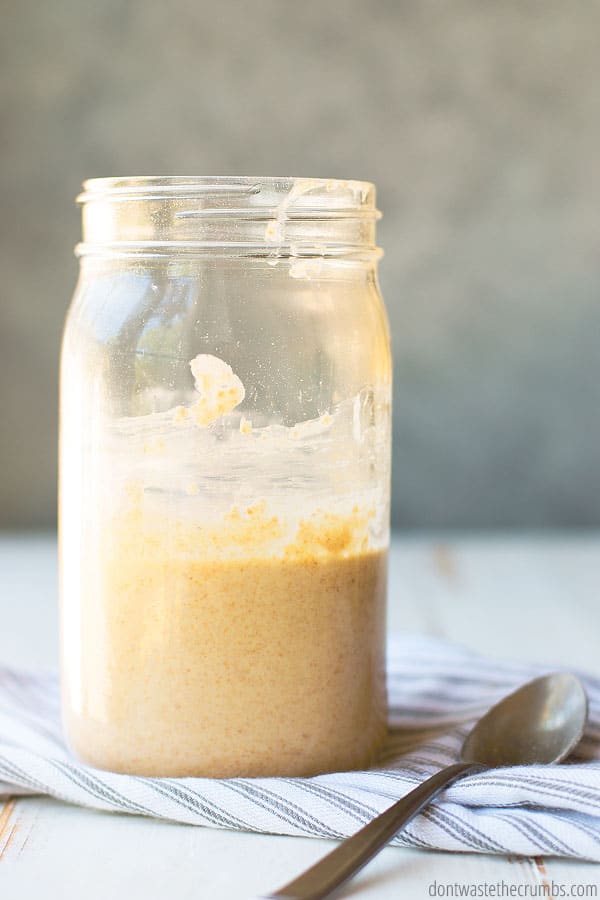
Why use einkorn flour for a sourdough starter?
But first, a brief history lesson and re-cap of why we’re currently using einkorn.
When we first switched over to real food, from a standard American diet (SAD) consisting mostly of boxed foods (read my full story here), I learned how to make bread. I primarily used bleached all-purpose flour.
When we finally figured out how to make real food work for our budget (thanks to the principles and system I now teach in Grocery Budget Bootcamp. Enrollment is currently closed, but you can join my FREE 5-day Crush Inflation Challenge and start saving money on groceries tomorrow!), I took a baby step and switched to store-bought whole wheat flour.
A little while after that, I invested in a grain mill and started grinding my own wheat at home. I learned how hard red wheat is great for bread and how soft white wheat is great for cookies and how hard white wheat was great for people who liked wheat bread that didn’t taste so “wheat-y.” (Read more about the different types of wheat here).
Fast forward a few years and my family and I did the Whole30. During reintroduction, we found that my daughter and husband are both sensitive to gluten.
I had done research on einkorn in the past and learned how some people who are sensitive to gluten can tolerate einkorn, so we took a couple months and used store-bought einkorn flour exclusively to see if anyone had any reactions.
No one did! So that’s why we use einkorn now.
Psst! If you’re interested in doing the Whole30 on a budget, here’s how our numbers panned out. You can also download our Whole30 meal plan for free here!
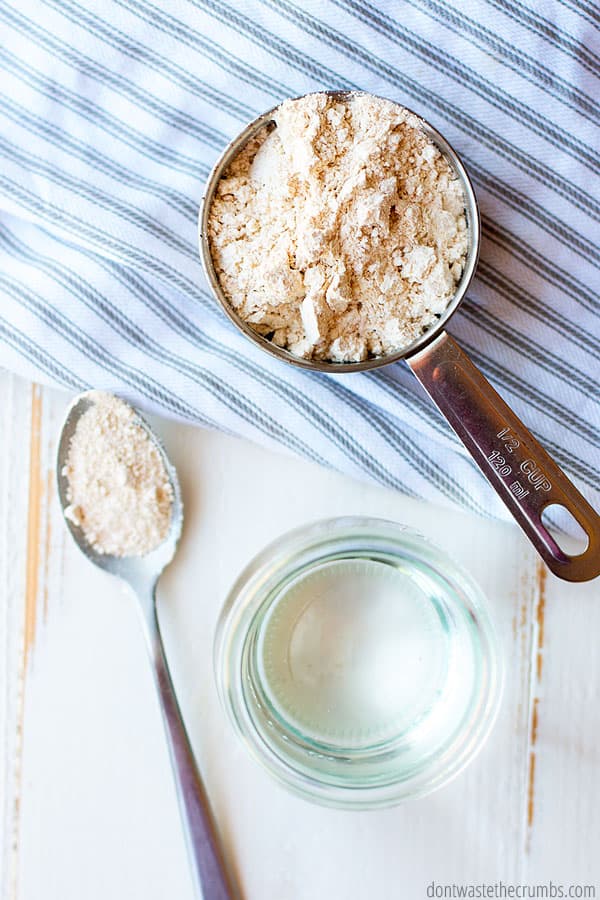
How to Make Einkorn Sourdough Starter
I know the idea of making a sourdough starter is intimidating, but I promise you it is REALLY easy. Watch – let me show you how to make an einkorn sourdough starter.
How to Make Einkorn Sourdough Starter: Supplies

You only need four things to make einkorn sourdough starter: a jar, a spoon, water and flour.
Jar
I used a pint-sized mason jar like this one for my sourdough starter, which made it easy to keep track of when to pour out the discard (when the jar was too full to stir!). You can use any jar you have though, so long as it holds at least 16 ounces.
Spoon
I broke two mason jars using a metal spoon, completely losing my entire starter the first time and almost half of it the second time.
I don’t know if my jars were old or if I stirred too vigorously, but because of this, I now only use a plastic spoon or silicone spatula. You can use a metal spoon, but “stir well” at your own risk!
Water
You want your water to be filtered if at all possible, simply because city water is treated with chlorine and fluoride and we don’t want that stuff in our foods.
We invested in this under-the-sink reverse osmosis filter system last year and we LOVE it. My husband is a plumber’s son and self-declared water snob and even he thinks our water is delicious!
Flour
You have a few choices when it comes to flour. Obviously we want einkorn flour, but you can use store-bought all-purpose, store-bought whole wheat, or freshly ground whole wheat (I recommend any of these).
I started with freshly ground whole wheat.
Note: I’ve searched local stores and the internet for the best prices on einkorn berries and Jovial Foods has the best price AS LONG AS you use the coupon DWCRUMBS. This will save you 10% off all items in the store with exclusions on special promotional items such as cookbooks and new harvest oil. Also, there’s free shipping over $99. Visit their site HERE.
The best price I’ve found for einkorn all-purpose flour is this seller on Amazon.
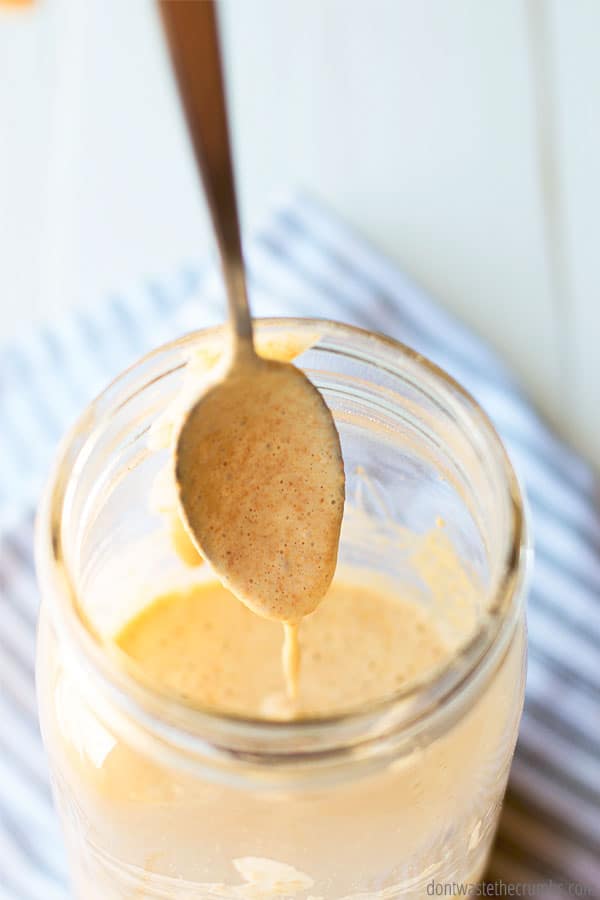
How to Make Einkorn Sourdough Starter: Method
Day 1, Morning: In a pint-sized mason jar, combine ¼ cup water and ¼ cup + 2 Tbsp flour. Stir well, scrape down the sides and cover with a piece of plastic wrap. Let it sit at room temperature, out of direct sunlight.
This combination of water + flour is called a feeding.
Day 1, Evening: Roughly 12 hours later, add another ¼ cup water and ¼ cup + 2 Tbsp flour. Stir well and cover with the same piece of plastic wrap. Let it sit at room temperature.
Day 2, Morning & Evening: Repeat the same as Day 1.
You may or may not see bubbles at the end of Day 2. If you don’t, it doesn’t mean your starter isn’t working. Just keep going.
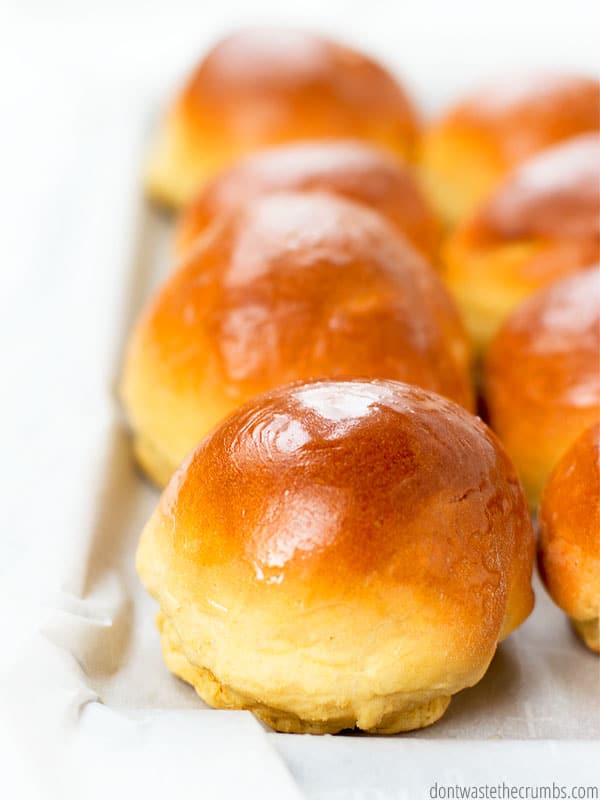
Day 3, Morning: Stir well first, then pour about half of the sourdough starter into another glass jar and place that jar in the fridge. This starter that you’ve poured off is called discard. Add another ¼ cup water and ¼ cup + 2 Tbsp flour.
When you’re creating a sourdough starter, it’s important that the beneficial bacteria multiply appropriately. By “discarding” some of the starter, you’re adequately feeding the beneficial bacteria. If you didn’t discard some of the starter, you would need to feed it MORE water and flour, which is essentially a waste of money this early in the process.
You can keep sourdough discard in the fridge for a few days and use it in lieu of liquid and flour in your favorite recipes. Some of my own tried-and-true sourdough discard recipes are sourdough biscuits and sourdough pancakes.
Day 3, Evening: Repeat the same as Day 1 Evening.
Day 4, Morning & Evening: Repeat the same as Day 1.
At this point, you may or may not see your sourdough starter dome an hour or two after you feed it. Einkorn sourdough starter doesn’t dome like a modern wheat or rye sourdough starter does, so don’t worry if your starter doesn’t LOOK much different.

Day 5, Morning: Repeat the same as Day 3, pouring about half of your starter into the jar of discard that you have in the fridge. Feed with ¼ cup of water + ¼ cup + 2 Tbsp flour.
Day 5, Evening: Repeat the same as Day 1 Evening.
Day 6, Morning & Evening: Repeat the same as Day 1.
The beneficial bacteria in sourdough thrives in warm environments. If you’re making a starter in the summer, or your home is on the warm side, you might see a yellow-ish liquid in your starter. This is called “hooch” and it’s the by-product when the good bacteria have eaten what you’ve fed them before their next feeding. This is totally normal!
When you’re first making a starter, I recommend stirring the hooch back into your starter before the next feeding. If you see hooch for two consecutive feedings, go ahead and discard half (like you did on Day 3 Morning and Day 5 Morning) and then feed.
Day 7, Morning & Evening: Repeat the same as Day 1.
Day 8: You’re done! You’ve successfully made an einkorn sourdough starter. See – wasn’t that easy?
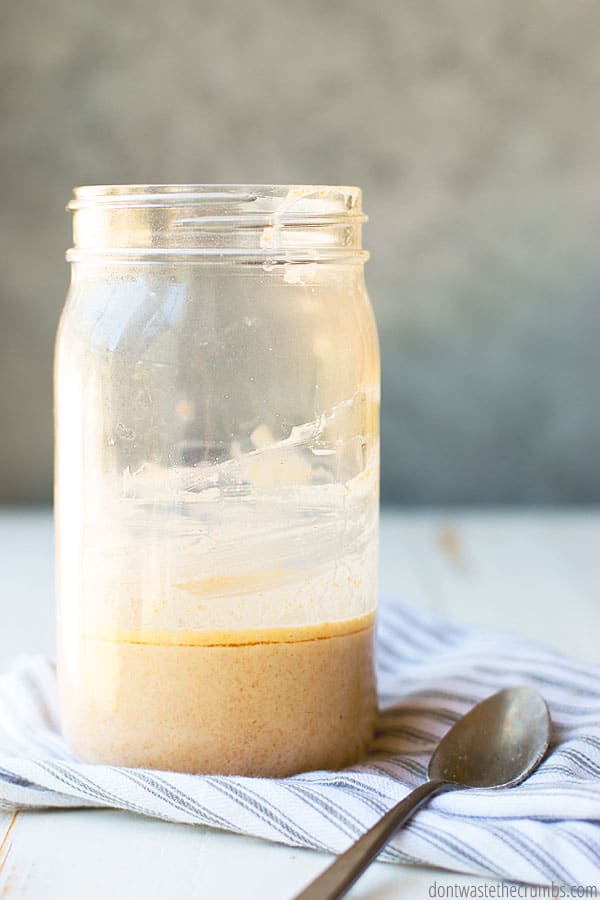
I had a lot of questions when I was making my einkorn sourdough starter, but thankfully I was following Wardee from Traditional Cooking School. She walked me through the entire process, step-by-step, and turned what originally felt like a kitchen experiment into something that now feels second nature!
You can read more about the ins and outs of sourdough in Wardee’s book: Sourdough A to Z – It is based on one simple idea: Imagine if five expert, traditional cooks invited you over for tea and blessed you with all of their secrets for creating healthy, delicious breads.
What an incredible resource I’ve come to love over the years!
Here are some of the questions I had, and the answers I found as I made my einkorn sourdough starter.
What should a sourdough starter smell like?
At first, the sourdough starter will smell like flour and water. It will evolve, though, into a sweet yeasty smell, to a strong yeasty smell, to a strong fermented smell that might make you think you did something wrong, and then back to a strong yet pleasant sourdough smell.
After 7 days, your sourdough starter should consistently have a pleasant smell. If it ever smells like vinegar, that’s acetic acid. It’s what the beneficial bacteria give off as they eat the natural enzymes in the flour. It’s normal, but it’s also a sign that you aren’t feeding the starter enough. I would suggest pouring off half of the starter into a discard jar, and then continue with regular feedings.
This happened to me when we went camping during a school break. I put my starter in the fridge and came home to what I thought was a ruined sourdough starter. After a few days of regular feedings and discarding the extra starter into my second jar, the pleasant smell returned.
If your sourdough ever smells BAD, like something crawled in your jar and died, you should probably start over.
Otherwise, keep pushing through. Strong and yeasty and fermented smells are normal.
When is a sourdough starter mature?
After one week, your sourdough starter is ACTIVE. That means you have beneficial bacteria that are doing their job and breaking down the enzymes in the flour. You can take your sourdough starter and use it to make things that don’t require yeast to rise, like biscuits or pancakes or waffles or banana bread.
Your sourdough starter is mature when it’s been alive for about 4 weeks. That is when the starter is strong enough to take the place of yeast in bread and other baked goods.
It’s like teaching a baby how to walk. They need to learn how to use those muscles first, and then the muscles will get strong enough to support the weight of the body.
The same goes for the beneficial bacteria. They’ll be young and will mature with time. There’s nothing you can do to speed up this process, so just enjoy the learning curve of how to bake with sourdough discard and look forward to homemade sourdough bread in about a month.
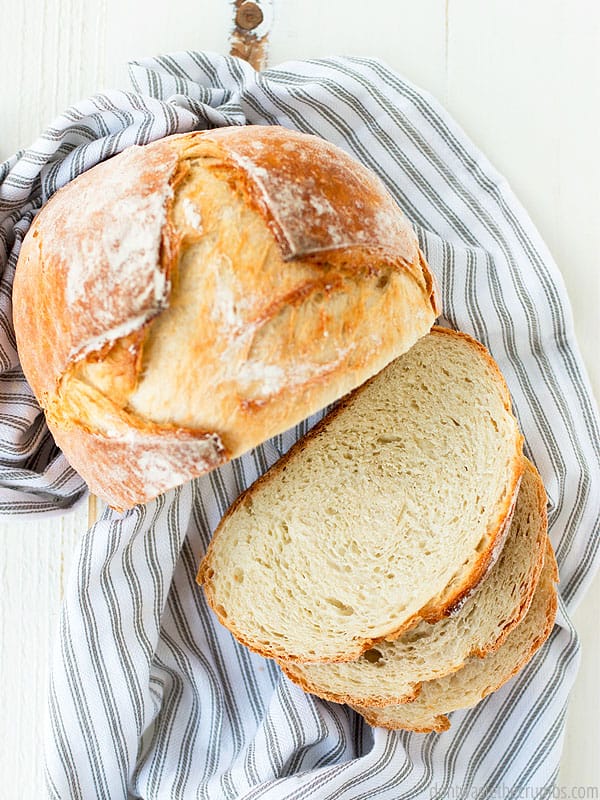
Typical Feeding Schedule for Einkorn Sourdough
During the first four weeks, you really want to be as consistent as possible with feeding your sourdough starter.
The feedings should be roughly 12 hours apart, so that can be 7am and 7pm, or 10am and 10pm, or noon and midnight – whatever works best for you.
I take the kids to school at 7:45 and they go to bed just after 8pm. For me, I’d feed the starter right before we left for school, and then as the kids started their bedtime routine.
Once your einkorn sourdough starter is mature (i.e. four weeks of consistent feedings), you can be a little lazier with your feedings.
I still like to feed mine twice a day, but I’ve reduced the amount I feed to just 2 Tbsp of water and 3 Tbsp of flour.
If my jar is getting full and I’m not making bread anytime soon, and I start to see a line of acetic acid, I make sure to stir well and pour half into my discard jar in the fridge. Then I’ll feed it like normal again.
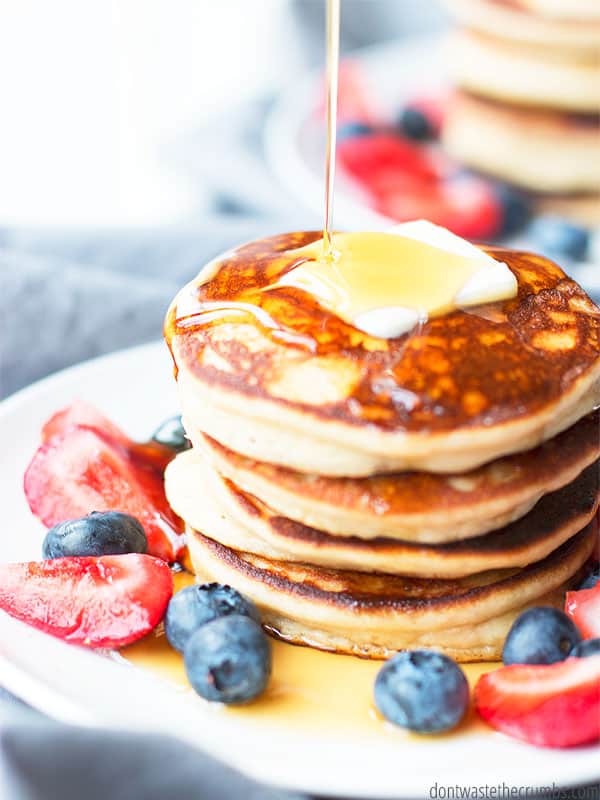
Here’s how to make a traditional sourdough starter and a simple loaf of sourdough bread.
Although the same issue of an active starter versus a mature starter comes into play there as well.If you want to learn more about sourdough – einkorn or not – I encourage you to check out Traditional Cooking School.
Wardee has everything you need in one handy spot, and she’s really covered all the bases!!






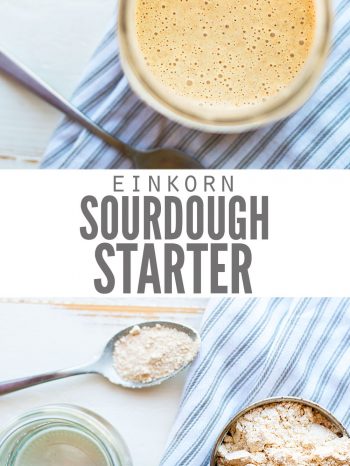
I’m confused. Is this starter recipe for whole grain Einkorn flour?
Hello Nydia,
Tiffany says, It can be I either one. I like using AP for starter personally, and then using WW if I want in the recipe, but if you only have WW, that will work too. Hope this helps!
Do you sterile the jar first? Why 1/4 cup and 1/4 in a row and then 2 tablespoons?
Hello Jeanine,
You need equal parts of flour/water to create the starter, but once you feed it, you can reduce the amounts so you’re producing less starter, and discarding less starter. Hope this helps!
Hi,
I have a dry Einkorn starter from Jovial and it’s just to dry for my liking. What would be your suggestions for making it more of a wet starter?
Hello Charlene,
Tiffany’s suggestion is to increase the water to flour ratio at the feedings to make a more wet starter.
Thank you so much for this recipe! This is my first time making a Sourdough starter. After the 8 days do I continue feeding and discarding half of the starter after 2 days?
Many thanks
Alissa
Hi Alissa,
After 8 days, all you have to do is just give it flour and water. You no longer need to discard half of it. Hope this helps!
I tried the Jovial method too and found it to be the same – too dry for my liking and really, to be truthful, to be more complicated a method to call it easy to do. I’m going to try the recommendations from this site to see if I like the results better. Thanks for asking this question, as I can learn from it too.
I did the jovial starter also and failed at it. It was super dry. I finally gave up. I’m going to try this one now.
I have to go out of town on day 7. Can I put it in the refrig and start feeding again when I get back 7 days later… ignore it in the refrig for 7 days?
Hi Sharron,
Tiffany says: If the starter is showing signs of being active, then yes. It just might take a bit to ‘wake it up’ when you get back.
Hi! Thank you for this. I am on day 6 and my starter more than doubles within 30min to an hour after feeding it. Do I just discard and feed it again? Or do I wait 12 hours to feed again. I’m going to have to move to a bigger jar I believe, will that hurt the starter to transfer? Yesterday it bubbled over the jar twice!
Hi Kalynn,
Tiffany says: You can move to another jar anytime you need to – it won’t hurt the starter! Doubling in size in 30 min is FANTASTIC!! Keep the feed at 12 hours. The size just means the wild yeast is doing what it should!
I’m heading into day 6 (tomorrow) my first couple of days my starter was doubling in size between feeds but after pouring off half (after stirring it) at Day 3, it is barely growing. It is definitely bubbling but not really growing. Is this normal or am I doing something wrong?? Following this recipe, using Einkorn AP Flour.
Hello Lynda!
Tiffany says that this is normal. Einkorn won’t grow or double like commercial all purpose flour. Bubbling is good and as long as the smell stays sourdough-ish, you’re good! Hope this helps! 🙂
Hi what ratio would you recommend for ap einkorn flour? I’ve seen others use 2:1 ratio flour to water. Thanks
Hi Matt,
For einkorn, Tiffany’s rule of thumb is 2:1 flour to water. She sometimes will do 3:1, when she wants a thicker starter. Einkorn takes longer to absorb liquid, so her personal preference is to start with a thicker starter and not have to add as much flour during the baking process. Hope this helps!
A couple questions, do you have the measurements in grams, when I discard some, should I put it in a a container to use for recipes and if so how long will it last, and after day seven, could I feed it once a day?
Hello Olivia,
Tiffany says “I don’t have the measurements in grams. I usually keep 2-3 Tbsp of starter and discard the rest. Yes, store your discard in a separate container. If you think you’ll have enough for baking in the next week or so, you can keep it in the fridge. You can continue to add to the discard as you have more discard, until you have enough for a recipe. Discard will last a long time in the fridge, 10-14 days easily. The longer it sits, the more hooch will accumulate. This is what gives sourdough the tang flavor. If you don’t want the tang or won’t have enough to bake in the next week, you can store it in the freezer. After day 7 of the starter, yes you can feed it once per day.” Hope this helps!
Is it possible to transition a white flour starter into an Einkorn starter?
Yes! Simply start feeding it Einkorn flour instead of white flour. According to Traditional Cooking School, you may need to add a little more flour than before and give it a few days to adjust to the new food source.
Hi! Thanks for these great instructions and the recipes………I wanted to ask you if there’s a printable version of the starter instructions (without pictures), and also, you mention you can use Einkorn AP, whole wheat or freshly ground…………which do you typically use? Because I’ve heard there can be major differences between using the AP or WW flour. I’ve been working on a starter for probably a couple of months now and have made a few decent loaves of bread but while my starter bubbles fairly well, and rises very well after feeding I can never get it to float!! So I was going to start over with your directions. TY!!
Hi Sandy! Great questions! We don’t have an easy print on that one since it’s not a full recipe.
About the flour, Tiffany says: I typically use Einkorn AP. My grain mill broke during our recent move so I haven’t been able to grind Einkorn Whole Wheat.
I’ve never used traditional float or stretch tests with Einkorn and to be honest, I’m not even sure they’ll work. Einkorn can be often subbed for regular all-purpose flour, but remember that it’s a totally different grain!
Hi- we have a family of 5 and eat bread often. Would a 16 oz had still be suitable? Should I get a larger jar and double the ingredients?
Hi Tiffany! You can start with a 16 oz starter and if it isn’t enough for your needs, split into another jar! It grows fast. 🙂
If you are baking with eikhorn can your starter be made with regular flour or must you use eikhorn for the starter as well?
Hi Lance! You can definitely use Einkorn flour with regular flour.
Ok, I made it day 8 several days ago, I’m a little confused on how to feed, am I still feeding 1/4 cup +Plus 2 TBSP of flour to 1/4 cup water throughout the 1st month (2x a day) or am I now doing the 3 TBSP flour to 1 TBSP water for the remainder of the first month? And do I discard at each feed, or every couple of days like during the first 8 days??
Hi Lynda,
Tiffany says- Once you get past Day 7, you can reduce the feeding to the lesser amount once per day. It’s developed, but not mature enough to bake bread – that comes at Day 30. As for discarding, you do that as often as you need to! I like to discard when my jar gets about halfway full (I use a 16oz jar at this point). Keep the discard in a separate jar in the fridge and use it in a recipe when you have enough.
Hope this helps!
On Day 6 Morning, I noticed black mold growing on the rim of my jar! The first thing I did was freak out a little bit, then I wiped off as much mold as I could and transferred the starter to a clean jar. I hope it’s okay – it still smells and looks fine. What I can do to prevent mold from growing?
Hi Cedar,
You did the right thing. Sometimes the mold happens. Try to keep the sourdough away from other ferments, and keep the area as sterile as possible. Hope this helps.
So excited, I have made it to day 8 with my 3 children (Sandy, Rachel and Pierre )
all are doing pretty well but I think Rachel is having a hard time currently.
question for feeding after day 8 ?? Do you continue to feed 2 x a day with a quarter cup plus 2 tablespoons of flour and quarter cup of water straight thru the 4 week mark or do you reduce the amount of feeding ?
also can you refrigerate after 4 week mark.
Hi Roxanna,
At day 8, you can reduce amount of feed and frequency of feed. Feed at least 1x/day. Yes, you can refrigerate after the 4 week mark. Hope this helps!
Hello
quick question please, I am new to Starters and sour dough bread.
in the instructions you basically pour off half the starter every 3rd day ? and feed
twice a day .
at what point is it safe to refrigerate ?
should you refrigerate after the first week or keep in open area ?
thank you
Roxanna,
It can either be kept out or in the fridge. If you are not intending to use it each day, it is best to keep it in the fridge. Hope this helps!
Tiffany ,
This is the best starter I have ever made. It’s beautiful! My question is: How much do I feed it starting into the 4 week maturing process? Is it still the 1/4 cup plus 2 TBL?
Hi Sharri!
As per Tiffany,
You have greater flexibility for feeding once you hit the 4 week mark. You can feed as little as 1-2 Tbsp, or as much as you need to build up enough to bake (any single feed should not exceed 3x the current amount of starter – so if you have 1/4 cup of starter, your max amount of a feed is 3/4 cup flour).
Hope this helps! 🙂
Hi,
Just want to say thank you for these wonderful starter directions. Tomorrow is my day 8 and Pensour is doing great. It’s been an exciting journey this far. We have made discard pancakes and they are delicious, so delicious that we have had them two breakfasts in a row. Huge plus is my hubby and kids are loving them. 🥰 Again Thank You